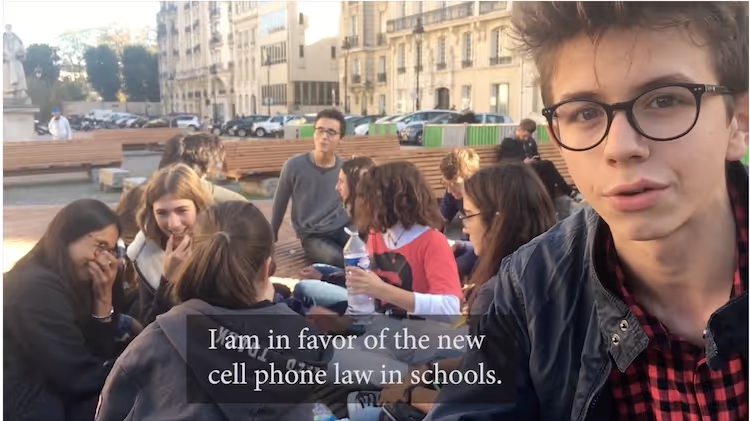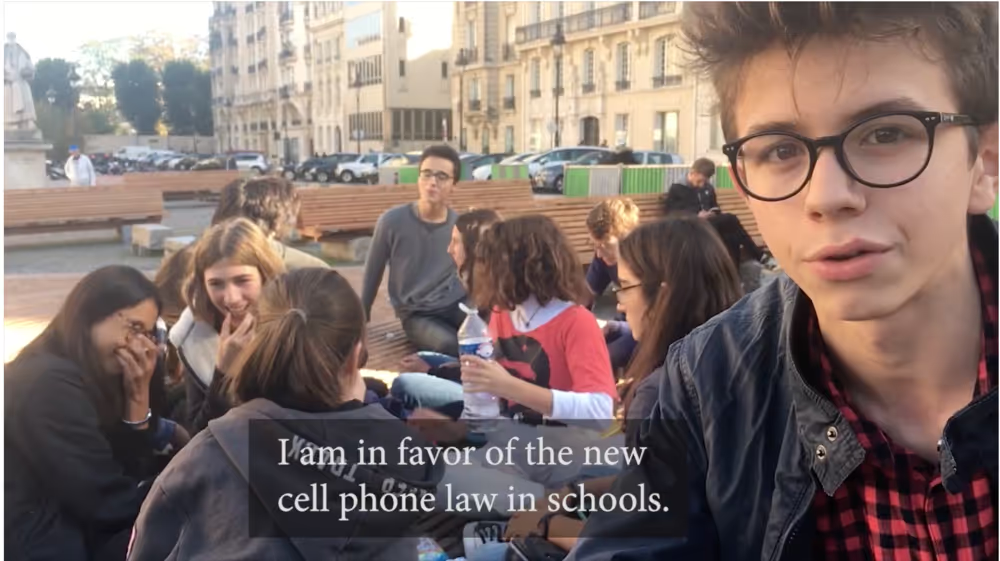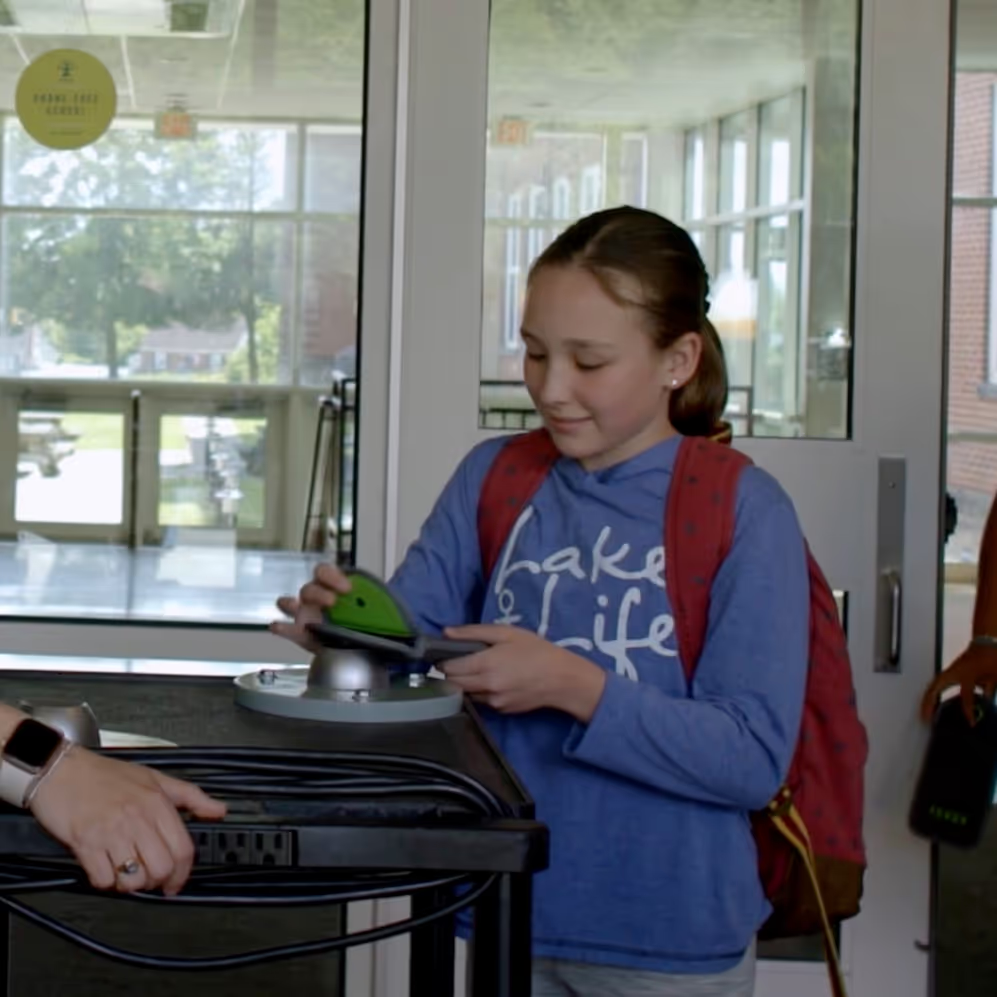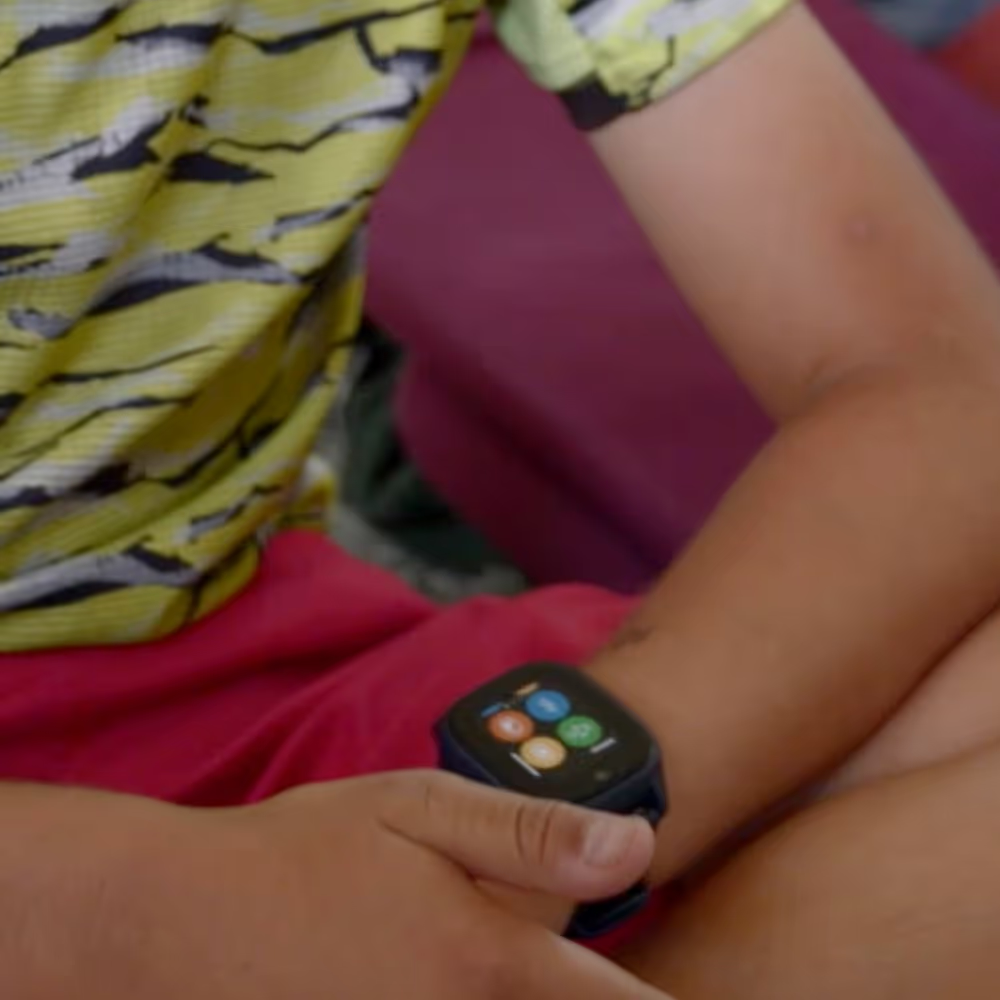



Policies, laws, rules—who makes them? Who follows them? Who agrees or disagrees with them? And, how can each of us get involved in making them? These are critically essential questions to bring up with youth, both in the abstract and in the specific. Today it is the specific—cellphones (something they can relate to).
Let’s take a few examples, starting with France. As of this past September, students age 15 or younger at public schools can no longer have their phones during the school day. I went there a month after the law started and you can watch student reactions to the law in this 1-minute video from my trip:
Next, a bill that was recently introduced in California by Assemblyman Muratsuchi that would, if passed, require California school boards to enact policies that limit or prohibit cellphone use in schools.
Around the same time the California bill was introduced, the government of Ontario, Canada announced a ban on cellphones in schools (except for specific instructional use) starting in the Fall of 2019.
And finally, in Hawaii, there is a bill circulating that would appropriate funds for the Department of Health to create a campaign to inform youth and adults about proven ways to reduce screen time.
When I started shooting Screenagers, some people would say to me, ”Why are you doing this film, the cat is out of the bag—tech is going to be unstoppable, and it is just too hard to limit it for youth, so don’t even try.” Luckily, I didn’t let these ideas stop me, and as the filming progressed, it became clear that there are very effective ways to engage youth in limiting screen time. At the same time it also became clear to me how critical it is for the entire village—schools, afterschool programs, parents, faith leaders, governmental bodies, and more—to work together to reduce screen time.
Another thing people often said to me was “Kids just need to learn on their own how to manage screen time.” I am a huge believer that learning from experience is important for youth, but when we are dealing with the intense developmental need for social involvement (i.e. social media), as well as the stimulation of video games, and much more, learning to self regulate on screens is not equal to other learning experiences. I am convinced we are often doing a disservice to youth when we put these devices in their pockets and assume they can overcome the onslaught of temptations.
Research shows that the upsides of youth having phones on them all day at school are outweighed by downsides. There are studies that show academic decline due to distractions of phones, and even just the presence of a phone is shown to decrease test scores.
Let’s also consider the impact of the emotions that occur throughout the school day from social media interactions when they have access to their phones at school. Last week my friend’s daughter received a prom proposal during lunch at school and within an hour most of the other teens at school learned about it through Instagram or Snapchat. Then, within a few hours, there were many meltdowns among girls who suddenly felt anxious that they would not get a proposal. Of course, this kind of reaction happened in the “olden days” pre-phone and social media, but the constant reminders and potential triggers were not there for youth throughout their school day (and beyond).
Today (or anytime this week) ask youth in your life about their thoughts on policies and cellphones:
We would love for you to share this TTT any way that works for you, whether that’s on social media or via a newsletter. If you want to send it out in your newsletter we just ask that you credit us and link to our website, and let us know at lisa@screenagersmovie.com.
HOST A SCREENING to help spark change.
FIND EVENT LISTINGS
Do you organize professional development in schools? We now have a 6-hour, 3-part training module. Request more information here Professional Development.
Stay in touch with the Screenagers community on Facebook, Twitter and leave comments below.
April 2, 2019
Here is a video from the Screenagers YouTube Channel that talks more about this subject
Learn more about showing our movies in your school or community!
Join Screenagers filmmaker Delaney Ruston MD for our latest Podcast

Learn more about our Screen-Free Sleep campaign at the website!
Our movie made for parents and educators of younger kids
Learn more about showing our movies in your school or community!
Learn more about showing our movies in your school or community!
Join Screenagers filmmaker Delaney Ruston MD for our latest Podcast

Learn more about our Screen-Free Sleep campaign at the website!
Our movie made for parents and educators of younger kids
Join Screenagers filmmaker Delaney Ruston MD for our latest Podcast
As we’re about to celebrate 10 years of Screenagers, we want to hear what’s been most helpful and what you’d like to see next.
Please click here to share your thoughts with us in our community survey. It only takes 5–10 minutes, and everyone who completes it will be entered to win one of five $50 Amazon vouchers.

Policies, laws, rules—who makes them? Who follows them? Who agrees or disagrees with them? And, how can each of us get involved in making them? These are critically essential questions to bring up with youth, both in the abstract and in the specific. Today it is the specific—cellphones (something they can relate to).
Let’s take a few examples, starting with France. As of this past September, students age 15 or younger at public schools can no longer have their phones during the school day. I went there a month after the law started and you can watch student reactions to the law in this 1-minute video from my trip:
Next, a bill that was recently introduced in California by Assemblyman Muratsuchi that would, if passed, require California school boards to enact policies that limit or prohibit cellphone use in schools.
Around the same time the California bill was introduced, the government of Ontario, Canada announced a ban on cellphones in schools (except for specific instructional use) starting in the Fall of 2019.
And finally, in Hawaii, there is a bill circulating that would appropriate funds for the Department of Health to create a campaign to inform youth and adults about proven ways to reduce screen time.
When I started shooting Screenagers, some people would say to me, ”Why are you doing this film, the cat is out of the bag—tech is going to be unstoppable, and it is just too hard to limit it for youth, so don’t even try.” Luckily, I didn’t let these ideas stop me, and as the filming progressed, it became clear that there are very effective ways to engage youth in limiting screen time. At the same time it also became clear to me how critical it is for the entire village—schools, afterschool programs, parents, faith leaders, governmental bodies, and more—to work together to reduce screen time.
Another thing people often said to me was “Kids just need to learn on their own how to manage screen time.” I am a huge believer that learning from experience is important for youth, but when we are dealing with the intense developmental need for social involvement (i.e. social media), as well as the stimulation of video games, and much more, learning to self regulate on screens is not equal to other learning experiences. I am convinced we are often doing a disservice to youth when we put these devices in their pockets and assume they can overcome the onslaught of temptations.
Research shows that the upsides of youth having phones on them all day at school are outweighed by downsides. There are studies that show academic decline due to distractions of phones, and even just the presence of a phone is shown to decrease test scores.
Let’s also consider the impact of the emotions that occur throughout the school day from social media interactions when they have access to their phones at school. Last week my friend’s daughter received a prom proposal during lunch at school and within an hour most of the other teens at school learned about it through Instagram or Snapchat. Then, within a few hours, there were many meltdowns among girls who suddenly felt anxious that they would not get a proposal. Of course, this kind of reaction happened in the “olden days” pre-phone and social media, but the constant reminders and potential triggers were not there for youth throughout their school day (and beyond).
Today (or anytime this week) ask youth in your life about their thoughts on policies and cellphones:
We would love for you to share this TTT any way that works for you, whether that’s on social media or via a newsletter. If you want to send it out in your newsletter we just ask that you credit us and link to our website, and let us know at lisa@screenagersmovie.com.
HOST A SCREENING to help spark change.
FIND EVENT LISTINGS
Do you organize professional development in schools? We now have a 6-hour, 3-part training module. Request more information here Professional Development.
Stay in touch with the Screenagers community on Facebook, Twitter and leave comments below.
April 2, 2019
Here is a video from the Screenagers YouTube Channel that talks more about this subject
Sign up here to receive the weekly Tech Talk Tuesdays newsletter from Screenagers filmmaker Delaney Ruston MD.
We respect your privacy.

Policies, laws, rules—who makes them? Who follows them? Who agrees or disagrees with them? And, how can each of us get involved in making them? These are critically essential questions to bring up with youth, both in the abstract and in the specific. Today it is the specific—cellphones (something they can relate to).
Let’s take a few examples, starting with France. As of this past September, students age 15 or younger at public schools can no longer have their phones during the school day. I went there a month after the law started and you can watch student reactions to the law in this 1-minute video from my trip:
Next, a bill that was recently introduced in California by Assemblyman Muratsuchi that would, if passed, require California school boards to enact policies that limit or prohibit cellphone use in schools.
Around the same time the California bill was introduced, the government of Ontario, Canada announced a ban on cellphones in schools (except for specific instructional use) starting in the Fall of 2019.
And finally, in Hawaii, there is a bill circulating that would appropriate funds for the Department of Health to create a campaign to inform youth and adults about proven ways to reduce screen time.
When I started shooting Screenagers, some people would say to me, ”Why are you doing this film, the cat is out of the bag—tech is going to be unstoppable, and it is just too hard to limit it for youth, so don’t even try.” Luckily, I didn’t let these ideas stop me, and as the filming progressed, it became clear that there are very effective ways to engage youth in limiting screen time. At the same time it also became clear to me how critical it is for the entire village—schools, afterschool programs, parents, faith leaders, governmental bodies, and more—to work together to reduce screen time.
Another thing people often said to me was “Kids just need to learn on their own how to manage screen time.” I am a huge believer that learning from experience is important for youth, but when we are dealing with the intense developmental need for social involvement (i.e. social media), as well as the stimulation of video games, and much more, learning to self regulate on screens is not equal to other learning experiences. I am convinced we are often doing a disservice to youth when we put these devices in their pockets and assume they can overcome the onslaught of temptations.
Research shows that the upsides of youth having phones on them all day at school are outweighed by downsides. There are studies that show academic decline due to distractions of phones, and even just the presence of a phone is shown to decrease test scores.
Let’s also consider the impact of the emotions that occur throughout the school day from social media interactions when they have access to their phones at school. Last week my friend’s daughter received a prom proposal during lunch at school and within an hour most of the other teens at school learned about it through Instagram or Snapchat. Then, within a few hours, there were many meltdowns among girls who suddenly felt anxious that they would not get a proposal. Of course, this kind of reaction happened in the “olden days” pre-phone and social media, but the constant reminders and potential triggers were not there for youth throughout their school day (and beyond).
Today (or anytime this week) ask youth in your life about their thoughts on policies and cellphones:
We would love for you to share this TTT any way that works for you, whether that’s on social media or via a newsletter. If you want to send it out in your newsletter we just ask that you credit us and link to our website, and let us know at lisa@screenagersmovie.com.
HOST A SCREENING to help spark change.
FIND EVENT LISTINGS
Do you organize professional development in schools? We now have a 6-hour, 3-part training module. Request more information here Professional Development.
Stay in touch with the Screenagers community on Facebook, Twitter and leave comments below.
April 2, 2019
Here is a video from the Screenagers YouTube Channel that talks more about this subject

This year, millions of students are experiencing a major shift: school days without phones, smartwatches, or other personal devices. Today we explore the wins, hurdles, and solutions helping schools succeed. We also share our resources that you can use to support technology policy changes in your schools.
READ MORE >
I recently sat down with middle school principal Zach at his school in Washington State. We talked about the challenges Zach and his team faced in his early years as principal when students used phones during school, and how he brought about a powerful transformation by having phones and smartwatches put away in locked pouches for the whole school day. In today’s blog, to raise awareness of the challenges, I share five real examples from Zach of the troubling ways students use phones at school to be unkind.
READ MORE >
It is with great pleasure that I share with you today a piece that Lisa Tabb and I did for Jonathan Haidt's (Author of The Anxious Generation) and researcher Zack Rausch's Substack blog — After Babel. In it, we discuss the rise in use of smartwatches in elementary schools and the problems they pose. There is a real cost to arming (pun intended) our kids with these devices and sending them to school. Now is the time to stop and fully address this topic and ensure that schools become smartwatch and phone-free.
READ MORE >for more like this, DR. DELANEY RUSTON'S NEW BOOK, PARENTING IN THE SCREEN AGE, IS THE DEFINITIVE GUIDE FOR TODAY’S PARENTS. WITH INSIGHTS ON SCREEN TIME FROM RESEARCHERS, INPUT FROM KIDS & TEENS, THIS BOOK IS PACKED WITH SOLUTIONS FOR HOW TO START AND SUSTAIN PRODUCTIVE FAMILY TALKS ABOUT TECHNOLOGY AND IT’S IMPACT ON OUR MENTAL WELLBEING.
